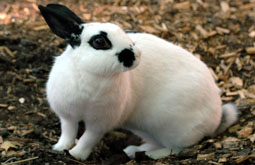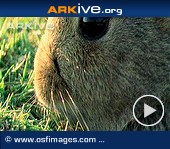Assiduous reproducers and good adapters
The rabbit belongs to the family of the leporidae and the hare and is a descendent of the wild rabbit. Wild rabbits reach a length of 35 to 45 cm and a weight of 1 to 2 kg. They are very agile and cunning. When calm, they hop but they are also good sprinters. In the wild, their average life span is less than a year. In human care, rabbits can reach 9 years of age. Learn more about the domestic rabbit here.
The wild rabbit adapts easily to its habitat. Today, wild rabbits can be found on all continents, with the exception of the Antarctic. The introduction to regions where the rabbit had few or no natural enemies led to major ecological problems. The rabbit’s pleasure in reproduction led to them becoming a plague in Australia and New Zealand, with nature and agriculture suffering from their rapid spread.
Rabbits prefer hilly terrain and loose ground as well as bushes to hide in. Rabbits like to eat sweet grass, clover, corn and grain. But they also feed on young pinewoods and the bark of thin broadleaf trees. Rabbits live in – partially very extensive – burrows which they dig themselves. Rabbits are social animals that live in hierarchically organized colonies.
Still wild – despite domestication
Domestic rabbits differ from wild rabbits with regard to various different characteristics. Their eyesight, sense of smell and taste, for instance, are less well developed. Moreover, domestic rabbits are far less shy and afraid of people. If domestic rabbits are crossed with wild rabbits, their offspring will demonstrate more characteristics of wild rabbits. Despite changes induced by breeding, in terms of biology and behavior, domestic rabbits today still largely resemble their wild ancestors.


